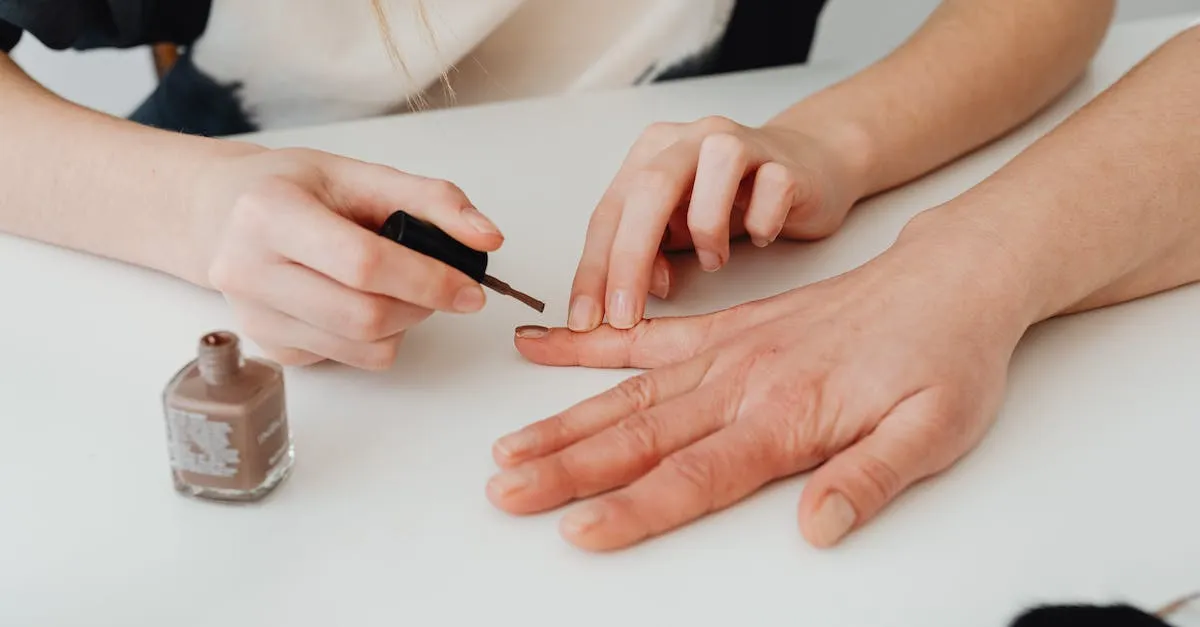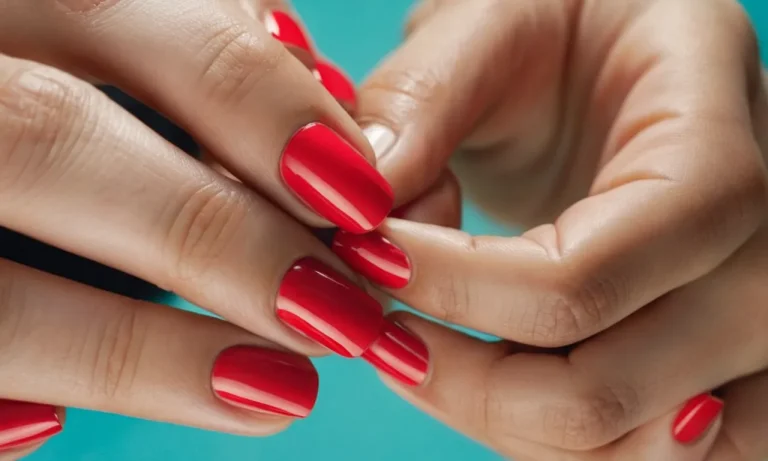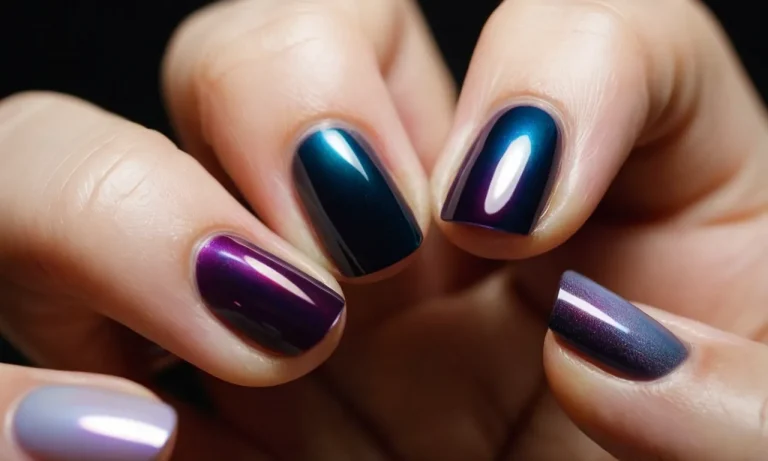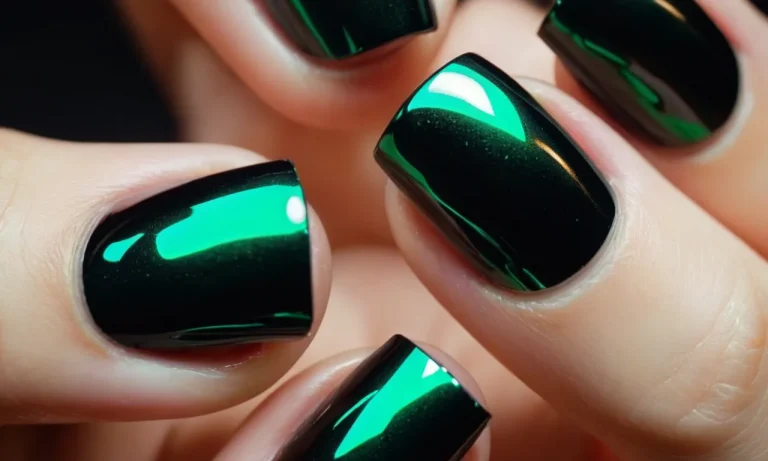What To Do When You Break A Nail And It Bleeds
Breaking a nail can be painful and lead to bleeding. If you’re short on time, here’s a quick answer: apply pressure with a clean cloth or tissue to stop the bleeding, clean the area, apply antibiotic ointment, and cover with a bandage.
Read on to learn more details about caring for a broken, bleeding nail.
In this comprehensive article, we will cover everything you need to know about dealing with a broken, bleeding nail. You’ll learn about stopping the initial bleeding, disinfecting the wound, using antibiotic ointment, properly bandaging the nail, speeding up healing, preventing infection, when to see a doctor, and more.
Stop the Bleeding
Apply Direct Pressure
When you break a nail and it bleeds, the first step is to apply direct pressure to the wound. This helps stop the bleeding quickly. Use a clean cloth or piece of gauze and apply firm, steady pressure for 5-10 minutes. This gives the blood time to clot and seal the wound.
If the bleeding is severe, apply pressure for up to 20 minutes. Elevating the hand above heart level also aids in slowing blood flow to the area.
Elevate the Hand
After applying direct pressure, keep the injured hand elevated above heart level. Gravity will help reduce blood flow and pressure in the hand and finger. Try propping your hand up on a pillow or the armrest of a chair.
Continue holding pressure to the nail and keep it elevated for at least 20 minutes. This dual approach helps close the wound more quickly.
Use Styptic Powder or Pencil (Optional)
You can also use a styptic pencil or powder to help stop minor nail bed bleeding. These products contain ingredients like aluminum sulfate and benzocaine that promote blood clotting and minor pain relief when applied to small cuts and cracks. Gently wipe away any blood from the nail bed first.
Apply styptic powder with a cotton swab or use the point of the pencil directly on the wounded skin. This quick-acting aid works alongside direct pressure to halt bleeding.
Disinfect the Nail
Wash Hands and Nail
Properly cleaning the affected area is crucial for preventing infection when you break a nail and it bleeds. Here are some tips for effective hand and nail washing:
- Wash your hands and injured nail with soap and warm water. Use mild or antibacterial soap if available.
- Gently clean around and under the broken nail with a soft brush or washcloth to remove dirt and debris.
- Avoid harsh scrubbing, which can cause further irritation.
- Rinse thoroughly with clean water and pat dry with a clean towel.
Washing helps remove bacteria and reduces the risk of the wound becoming infected. Be sure to thoroughly clean the skin around the nail, not just the nail itself. Pay close attention to removing any visible dirt or foreign matter stuck under the nail or in the cuticle area.
Use Antiseptic or Hydrogen Peroxide
After thoroughly washing the nail and surrounding skin, apply a medicated ointment or solution. This helps kill any remaining germs and further protect against infection.
- Use an over-the-counter antibacterial ointment or cream. Look for ones containing neomycin or polymyxin B sulfates.
- Try an antiseptic solution like hydrogen peroxide. Hydrogen peroxide foams up and cleans inside the wound.
- Lightly soak a cotton ball with the antiseptic and gently dab on the nail and cuticle area. Don’t wipe or rub harshly.
- Allow the area to air dry. Do not bandage or cover the nail yet.
Using a medicated ointment or antiseptic provides an extra layer of germ-killing power and protection. This reduces the chances of complications like paronychia (nail infection). However, avoid using alcohol or iodine solutions, as these can slow healing.
Apply Antibiotic Ointment
When you break a nail and it bleeds, it’s important to clean the area and apply antibiotic ointment to prevent infection. Here’s a step-by-step guide on how to properly care for a bleeding broken nail:
Clean the Area
First, you’ll want to stop the bleeding by applying pressure with a clean towel or piece of gauze. Once the bleeding has stopped, wash your hands and the injured nail bed with soap and warm water. This helps remove any dirt or bacteria that could cause an infection.
Disinfect the Area
After washing, apply an antiseptic like hydrogen peroxide, alcohol, or iodine to the cuticle and nail bed. This will sting a bit, but it’s important to disinfect the area where the nail broke to prevent bacteria from getting in.
Once the area is clean, apply a thin layer of antibiotic ointment like Neosporin. This will help keep the cut moist and prevent infection. Be sure to get the ointment into the nail bed and cuticle area where the nail broke.
Bandage the Nail
After applying the ointment, you can cover the nail with a bandage or adhesive bandage. This will keep the nail protected and keep the ointment in place. Change the bandage daily and apply more ointment each time.
Watch for Signs of Infection
Over the next several days, watch the nail for signs of infection like increased pain, redness, swelling, drained fluid, or fever. If you notice any of these symptoms, see your doctor right away. Infections need to be treated with oral antibiotics.
With proper cleaning and antibiotic ointment, most small nail breaks will heal just fine on their own. But it’s still important to closely monitor the nail and surrounding skin for any worrisome symptoms.
Paying attention and acting quickly can help prevent a minor nail injury from turning into a nasty infection.
Bandage the Nail
Use Adhesive Bandage or Finger Cot
If your broken nail is bleeding, it’s important to properly bandage it to avoid infection and promote healing. An adhesive bandage or finger cot specifically designed for finger injuries can help protect the nail and stop bleeding.
According to the American Academy of Dermatology Association (AAEA), you should first clean the injured nail and surrounding area with mild soap and water. Gently pat dry before applying an antibiotic ointment like Bacitracin or Polysporin. This helps prevent infection.
Next, cover the nail with a sterile adhesive bandage or finger cot, wrapping it around the tip of the finger to keep it securely in place. The AAEA recommends changing the bandage daily, or more often if it gets wet or dirty. This helps keep the injured area clean while the nail heals.
Using a properly wrapped finger bandage prevents further trauma to the delicate nail bed. It also absorbs drainage and keeps debris out that could cause redness or swelling. Be sure to select a breathable bandage to allow air circulation.
Change Bandage Daily
As mentioned above, it’s important to change the bandage on your broken nail every 24 hours. Or anytime the bandage becomes loose, wet or soiled.
According to leading healthcare provider Johns Hopkins Medicine, changing the bandage helps prevent bacterial infection and encourages healing:
- Keeps the area clean and dry
- Absorbs drainage from the nail bed
- Allows you to monitor healing progress
- Replace with a fresh antibiotic ointment
Be sure to wash hands thoroughly each time before reapplying a clean bandage. Carefully wipe away any drainage or debris around the nail. Apply more antibiotic ointment and rewrap with a sterile bandage or finger cot.
The nail may take several months to fully regrow. Properly bandaging and changing dressings daily helps facilitate healthy regrowth and prevents complications.
If redness, swelling, oozing or increased pain occurs, contact your healthcare provider. This could indicate a possible nail bed infection requiring medical treatment with oral antibiotics.
Promote Healing
Use Topical Vitamin E
Vitamin E is well-known for its healing and moisturizing properties. When applied topically to a broken nail, vitamin E can help speed up the healing process. Its antioxidants promote new skin cell growth while the emollient properties help keep the nail and surrounding skin moisturized.
For best results, apply a vitamin E oil or cream directly onto the nail and cuticle 2-3 times a day until fully healed. Some great vitamin E products to try are Jason Vitamin E Oil which contains a whopping 5000IU of vitamin E per ounce, or Burt’s Bees Vitamin E Cream which contains sunflower and soybean oil for extra moisture.
Take Oral Vitamin C
In addition to using topical vitamin E, taking an oral vitamin C supplement can also help heal a broken nail fast. Vitamin C is essential for collagen production, which is needed to help repair and rebuild damaged nails.
Aim for around 500-1000 mg of vitamin C once or twice daily until the nail has fully grown out. For extra benefit, use a vitamin C supplement that also contains zinc like Nature’s Bounty Vitamin C. Zinc is another key nutrient for strong, healthy nails.
Taking vitamin C with bioflavonoids will also increase the nutrient’s antioxidant power and effectiveness.
Keep Nail Moisturized
Preventing moisture loss is key when healing a cracked or broken nail. Using an intensive nail and cuticle cream 1-2 times per day will help keep the nail well-hydrated as it mends. Look for moisturizing ingredients like shea butter, coconut oil, glycerin, and jojoba oil.
Applying a layer of petroleum jelly over the nail before bedtime can also seal in moisture overnight. For severely cracked nails, wearing cotton gloves after applying cream can boost hydration. Some top-rated nail moisturizers are Burt’s Bees Intense Hydration Cream, Sally Hansen Cuticle Rehab, and Nailtiques Protein Formula.
Prevent Infection
Keep Area Clean
Keeping the area around a broken, bleeding nail clean is crucial to prevent infection. Gently wash your hands with warm water and mild soap, being careful not to disturb the injured nail bed. Rinse thoroughly and pat dry with a clean towel.
You can apply an antibiotic ointment like Neosporin to help keep germs out. Cover with a bandage or adhesive bandage, changing it daily or whenever it gets wet. Be sure to wash your hands before changing the bandage. Clean any blood or fluid that leaks out as well.
Keeping things clean prevents bacteria from entering and decreases infection risk.
It’s also important not to touch the broken nail or peel back the skin. This can introduce more bacteria and delay healing. Trim other nails short to avoid catching them on the bandage. Soaking the nail in warm water with Epsom salts may help relieve throbbing.
Just mix a tablespoon into a small bowl of water. Doing this 2-3 times a day keeps the area clean.
Watch for Signs of Infection
Even with good nail care, infections can sometimes still occur. Be on the lookout for symptoms like increased pain, swelling, redness, warmth around the nail, red streaks, pus, foul odor, or fever. These are all signs of a possible bacterial or fungal infection. If you notice any of them, call your doctor right away.
Infections need to be properly treated with prescription medications to prevent them from spreading or getting worse.
Left untreated, a nail infection can lead to losing part or all of the nail, or the infection spreading into the finger and hand. Diabetics and those with weakened immune systems have a higher risk of developing infections and should be extra careful monitoring nails daily.
But even healthy individuals can develop nail bed infections that require medication. At the first sign of infection, see your doctor.
When to See a Doctor
Seeing a doctor after breaking a nail and having it bleed may not always be necessary. Here is some guidance on when it’s a good idea to seek medical care:
Signs of Infection
If the area around the broken nail becomes increasingly red, swollen, warm, or painful over the next 24-48 hours, it could signify an infection developing. Other symptoms of a nail infection include:
- Green or yellow drainage from the cuticle area
- A foul smell around the nail
- Fevers or chills
Infections require antibiotic treatment, so seeing a doctor right away is recommended if any of these signs occur.
Excessive Bleeding
While some bleeding when a nail breaks is normal, excessive bleeding that lasts more than 5-10 minutes or bleeds through multiple bandages may indicate a more serious injury. This level of bleeding warrants a medical evaluation to check for damage to the nail bed or fingertip and determine if stitches are needed.
Inability to Stop the Bleeding
If simple first aid like applying pressure with a clean bandage does not stop the bleeding within 10-15 minutes, seeing a healthcare provider is a good idea. They can properly clean, examine, and dress the injured nail bed to get the bleeding under control.
Underlying Health Conditions
People managing health problems like diabetes, autoimmune diseases, or taking blood thinners face impaired healing and an increased infection risk with any cuts or injuries. For these higher-risk groups, getting injuries checked by a doctor sooner rather than later is generally wise.
Conclusion
Breaking a nail can be a nuisance, but following these first aid steps can help stop bleeding fast, prevent infection, and promote healing. With proper care, your nail will be back to normal in no time. Remember to see a doctor if pain persists, bleeding won’t stop, or signs of infection develop.
Taking quick action when you break a nail can help you get back to your usual activities fast.







